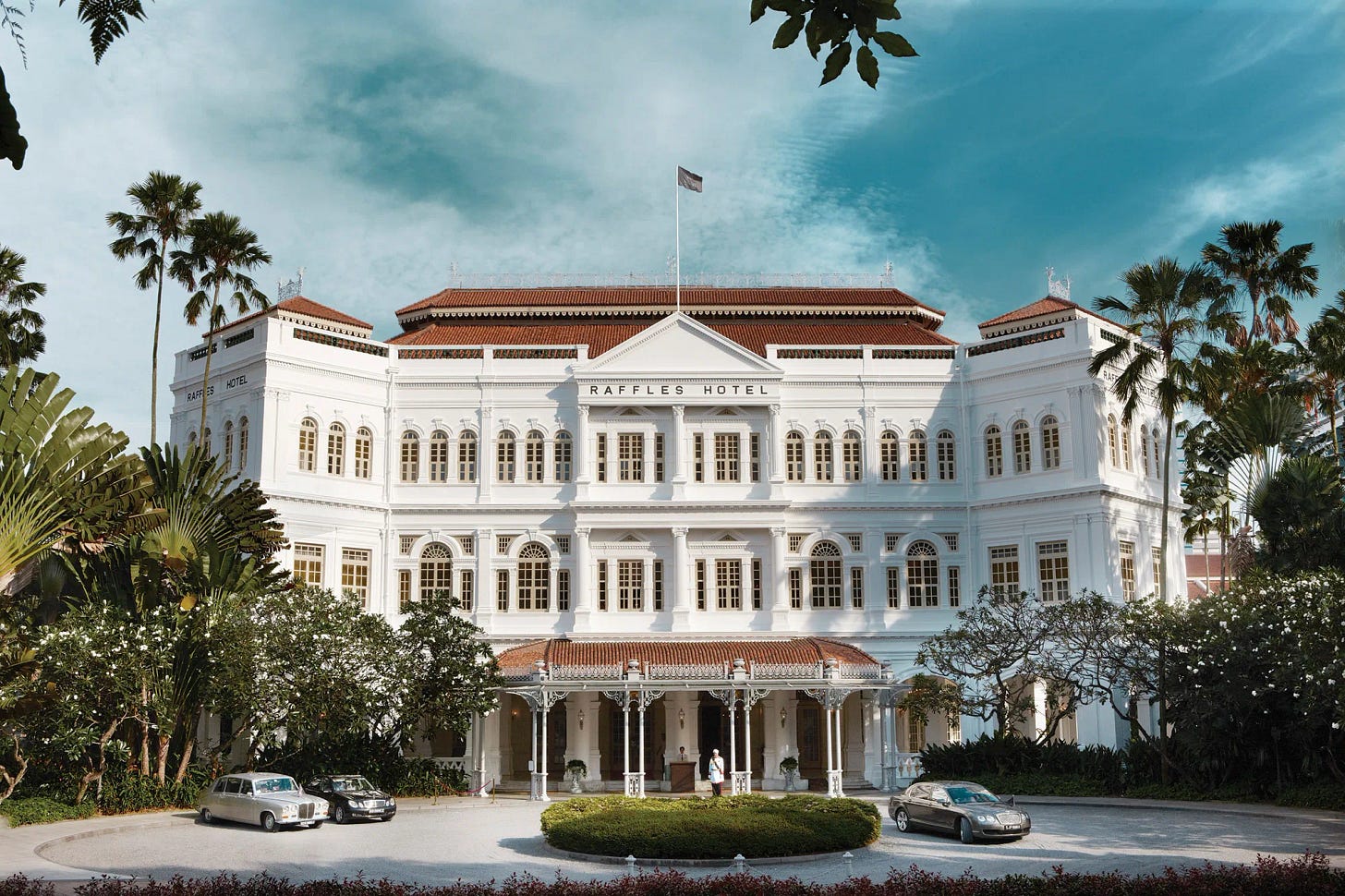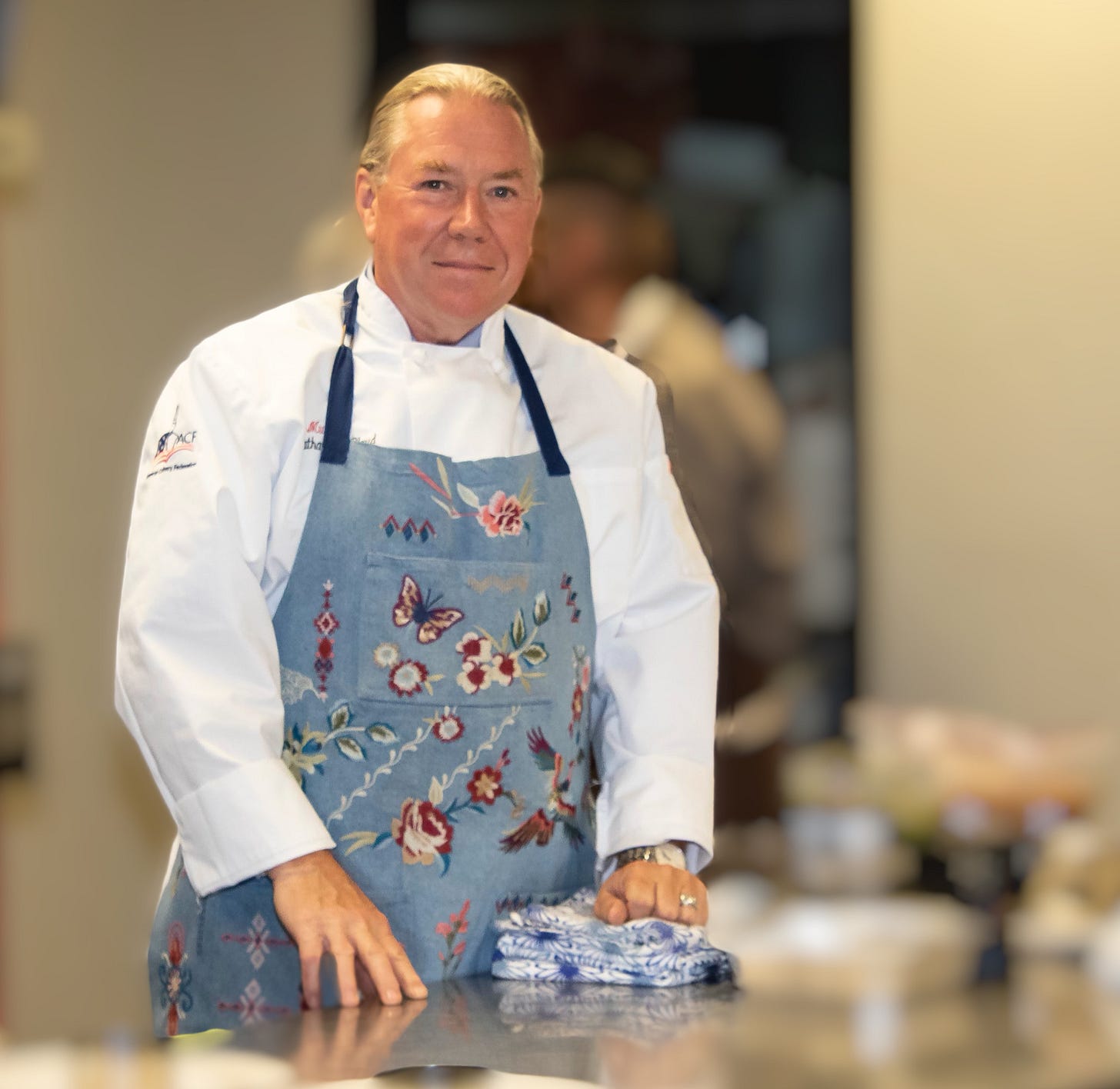Cocktail Hour @ The Intentional Table
Libations to make the heart and conversation grow warmer.
Greetings! It’s Cocktail Hour at the Intentional Table!
The Hidden Story Behind the Singapore Sling: From Hotel Bar to Global Icon
Ah, you may have thought I was headed right for Irish Whiskey. No! Too easy. Let’s go to Dublin, hang a right, and go 1,200 Kilometers and ta-da… you are there!
Have I told you how much I love this beverage? Well, as long as it’s not too sweet, which it sometimes is, and if it does not come out of one of those big slushie machines I have seen, this beverage deserves some storied respect. Just like any fine beverage, e.g., a Negroni ( have we talked about those yet? ), there is always a tatter over who thought it up.
The Singapore Sling is one of the world’s most famous cocktails, born at a time when it was unseemly for women to drink alcohol in colonial Singapore. In the early 1900s, the Long Bar at Raffles Hotel debuted this pink-hued mix, cleverly disguising its booze behind fruit juices and a feminine look. If you look at my last post, you will see that I am about equal treatment for all humans, and thus, let’s poke at taboo a wee bit, shall we?
But this cocktail is more than a pretty drink—it’s woven into a fascinating tale of innovation, social shifts, and cultural evolution. From mysterious origins and recipe disputes to becoming a global emblem of Singapore’s heritage, the Singapore Sling has kept its charm for over a century. Its journey from a local bar creation to an international icon says a lot about society’s changing attitudes and the art of mixology. Thank goodness for that. Bring it on!
A Drink for the Times
Who was Ngiam Tong Boon?
Raffles Hotel’s official story credits Hainanese bartender Ngiam Tong Boon with creating the Singapore Sling in 1915. It was designed to let women enjoy liquor openly, as ladies were discouraged from drinking in public. Yet conflicting accounts hint Ngiam may have passed away in Hainan in 1915, the same year the Sling supposedly appeared. His name only rose to prominence in the 1970s, when Raffles Hotel revitalized its image.
Regardless of the exact timeline, Ngiam clearly strongly influenced Singapore’s hospitality scene. As bar captain at the city’s top hotel, he worked with other Hainanese immigrants and reportedly made savvy business investments with colonial connections. The Raffles Hotel is about as close to an epic-sized grand dame as I have ever seen. It’s astonishing how beautiful it is (again), and the size of the bar is equally astonishing. It feels like a football field. Really. There is a reason they call it a “Long Bar.”
Colonial norms and hidden cocktails
In the early 1900s, Singapore was shaped by strict British social rules. Elite men gathered at clubs like the Raffles Long Bar for post-sport cocktails, calling the Sling a “drink for the gods.” However, respectable British women were not welcome in most bars and social clubs, which mirrored similar restrictions in America. A pink, fruit-based drink offered a subtle way for them to indulge without backlash. However, men also enjoyed it—original accounts describe a stronger, darker red version than the lighter, modern incarnation. Some say it was the Pussers Rum, a dark invention from the British West Indies.
The Original Recipe Mystery
Perhaps no other cocktail’s ingredients spark as much debate. Many different “official” recipes have popped up over the decades, and the original formula reportedly vanished or was stolen long ago.
Lost recipes and varying sources
The Raffles Hotel eventually admitted to losing Ngiam’s recipe, relying instead on a note scribbled by a curious guest in 1936. The cocktail became even harder to pin down when the hotel changed hands during World War II, and original documents disappeared. Another layer of confusion came from claims by Ngiam’s relatives, who supposedly verified a recipe including pineapple juice, Benedictine, and other additions now associated with the Sling.
Yet historical evidence reveals references to “slings” in local papers as early as 1897, hinting that the drink may not have been solely Raffles’ invention. Some newspapers mention cherry brandy, gin, Benedictine, bitters, and lime juice before 1915, suggesting multiple sling variations were already floating around.
Cherry brandy or Kirschwasser?
One of the biggest sticking points is the type of cherry spirit. Early references to a rosy hue suggest a red liqueur (like Cherry Heering), not the clear kirschwasser that some recipe books list. Ads from the early 1900s show both Heering and Bols cherry brandy were available in Singapore, reinforcing the idea that a red cherry liqueur gave the Sling its signature color. Over time, different bartenders tried new twists, leading to even more disagreements about which version was “right.” I love that. Dueling drink histories. Easy to argue about when you have had 1 or 2 of them.
From Local Specialty to World Fame
Thanks to global travelers, the Singapore Sling spread beyond the Raffles Hotel. By the 1920s, it had appeared in cocktail books worldwide, each with a slightly different formula. Renowned writers like Joseph Conrad and Rudyard Kipling sampled it, sharing tales of a captivating pink drink sipped amid the grandeur of colonial Singapore.
Celebrity endorsements only boosted its status. By the mid-1900s, it had become a staple in Tiki bars, part of a larger wave of exotic cocktails. Today, Raffles Hotel sells upwards of 800 Sling cocktails a day, proving that a once-local curiosity is now both a moneymaker and a cultural icon. Told you the bar was big.
Changing Recipes Over Time
Since the 1930s, the Singapore Sling has evolved to match shifting tastes. Early recipes were simpler: gin, cherry brandy, lemon or lime juice, and soda. Post-war versions added sweeteners and exotic juices, sometimes morphing into a sugary neon-pink concoction barely resembling the original. By the late 20th century, Raffles Hotel promoted a recipe loaded with pineapple juice, Benedictine, Cointreau, grenadine, and bitters.
In 2015, marking the Sling’s 100th anniversary (as per hotel lore), Raffles tried to dial back the sweetness, adding custom grenadine and local spices. Although modern incarnations might not mirror the original, they’ve earned global recognition. This evolution reflects the reality that cocktails adapt with the times, appealing to changing palates and markets.
Cultural Significance
Few cocktails are so closely tied to a city’s identity. Sipping a Singapore Sling at the historic Long Bar is a bucket-list experience for many. Airlines serve it on flights to the city-state; visitors come from all over to say they’ve tried the “national drink.”
In Singapore, there’s a divide between locals—many of whom see the Sling as a tourist novelty—and global fans who view it as a travel tradition. Still, it remains an enduring emblem of Singapore’s colonial past and modern global aspirations. Its story touches on social class, women’s rights, and the blending of Asian and Western influences.
The Singapore Sling demonstrates that a simple cocktail can represent a nation’s history and cultural changes. Debates over its original recipe haven’t dimmed its glow as a travel icon and conversation starter. Born to navigate colonial social norms, it has grown into a world-famous drink with a rich backstory. If there is anything that I want from a stiff drink, it’s the power to change the outcomes!
Some see it as a tourist gimmick; others appreciate the flavor and heritage. Regardless, the Sling’s enduring charm lies in the tale it tells—of hidden opportunities for women, of bartenders whose names have slipped into legend, and of Singapore’s evolution into a global hotspot. Order one at the Long Bar, and you’ll be holding a piece of living history in your hand. I may have had a ‘couple’ as I was staying there, but that story is hidden in the annals of approximately… 1997… I think.
Blessing from this Intentional Table and its humble cook.
Cheers!










Love this! Reminds me of the Lambeth Walk Fizz cocktail recipe I adapted from James Beard winning bar Maison Premiere for easy home mixing!
It’s a decadent ode to New Orleans culture, giving the creamy Ramos Gin Fizz a tropical, Willy Wonka-esque spin.
check it out:
https://thesecretingredient.substack.com/p/get-james-beard-winner-maison-premieres